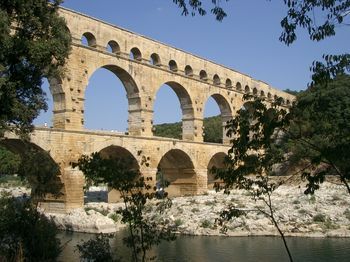History of Bridges
The bridge is a structure that provides passage over obstacles such as valleys, rough terrain, or bodies of water by spanning those obstacles with natural or human-made materials. They began being constructed in ancient times when modern civilizations started rising in Mesopotamia. From then on, knowledge, engineering, and manufacturing of new bridge-building materials spread beyond their borders, enabling bridges' slow but steady adoption worldwide.
In the beginning, bridges were simple structures built from easily accessible natural resources- wooden logs, stone, and dirt. Because of that, they could only span very close distances, and their structural integrity was not high because the mortar was not yet invented, and rain slowly but constantly dissolved the dirt fillings of the bridge. A revolution in bridge construction came in Ancient Rome, whose engineers found that grinding out volcanic rocks could be an excellent material for making mortar. This invention enabled them to build much sturdier, more powerful, and larger structures than any civilization. Seeing the power of roads and connections to distant lands, Roman architects soon spread across Europe, Africa, and Asia, building bridges and roads of very high quality.

Bridges History
Bridge history is filled with incredible achievements and new technologies that enabled bridges to become one of the most important tools of bridging cities, countries and continents. This is their story.
Facts about Bridges
During their long history, bridges managed to influence our culture and improve the way we travel, do business and forge policies. Here you can found out some of the most incredible facts about bridges.
Most Famous Bridges
If you want to know what bridges ar the most famous in the world, here is the perfect place to do so. Learn about historical bridges, marvels of modern engineering and bridges with the designs that will live forever.
Model Bridge Building
Model bridge building is a popular pastime, where hobbyists create bridge models from various materials like spaghettis, toothpicks, balsa wood, etc. Miniature bridge making is also often used in education in areas like physics and engineering. Numerous competitive bridge building contents are held annually, with various rules and goals.

One of the defining successes of Roman bridge architecture was the discovery of arches. Using this type of building, load forces of the bridge were conveyed to move along the curve of the arch, meeting with the ground where supports on the end of the arch canceled them. Because of that, Romans were able to create bridges that were much lighter than before and held loads twice as heavy as the bridge itself. In constructing their numerous aqueducts, Roman architects even managed to create water-carrying bridges with multiple arched tiers that reached incredible heights!
Using this new building technique, Romans could quickly produce cheap, light, and very powerful bridges from materials they found near the project. The only material that had to be imported from Italy was mortar dust, which was combined with water and inserted into the bridge structure.
After the fall of the roman empire, bridge-building techniques in Europe and Asia stagnated until the 18th century (if we ignore the introduction of Rope suspension bridges that were brought back to Europe from Central and South America) when the new age of science and engineering swept across the world. Architects of that time started using new construction material – cast iron! Iron enabled the creation of new bridge designs, such as truss systems. Sadly, wrought iron did not have the tensile strength to support heavy structures, which was fixed with the advent of steel and the ideas of famous French architect and engineer Gustave Eiffel.
Modern bridges are usually made with concrete, irons, and cables. They can be built from very small sizes to incredible lengths that span entire mountains, rough landscapes, lakes, and seas.

